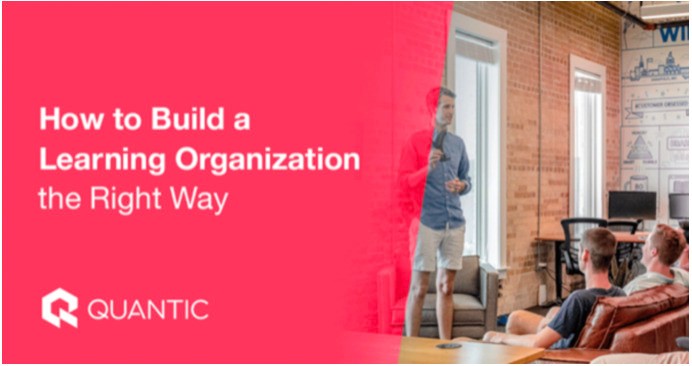CAREER PLANNING
How To Build A Learning Organization The Right Way In 2024
Our business world is complex. The traditional approach to doing business is at a crossroads. Employee satisfaction, corporate power, and healthy competition are often under scrutiny.
Many of the problems organizations face today are related to their learning methods. This includes their ability to change and take up competitive challenges.
Organizational learning has proved key to survival in this demanding environment. In it, employees share decision-making powers and corporate accountability.
Organizational learning helps businesses adapt to environmental uncertainties and learn from past mistakes. This critical knowledge is useful in the days ahead.
Organizational learning brings operational efficiency. Yet, it comes with uncertainty. Many organizations struggle to apply its principles to their daily operations.
Today, we’ll take an evidence-based approach to the practices of organizational learning. We’ll consider the associated method that organizations need to apply its principles.
What Is a Learning Organization?
Experts in learning organization theory have had a hard time finding an exact definition of a learning organization.
In his book, The Fifth Discipline: The Art & Science of The Learning Organization, Peter Senge defines learning organizations as those that:
Learning organizations should respond to present-day pressures. This is useful for competition.
Learning Organization Characteristics/Culture
A learning organization’s culture has the following 5 dimensions.
Systems Thinking
This approach encourages a collaborative learning pattern. Individuals bring in their innovation as part of the whole framework.
Quantic offers a group-learning platform. This includes classmate interaction and class exercises. They also build knowledge together weekly.
Personal Mastery
Corporate learners are challenged into a lifelong learning mindset. They thus develop personal mastery and get the results they desire most. The Skills obtained are applied in real life.
Quantic’s lessons are interactive, emphatically testing a learner’s understanding. Coaches on the platform help learners apply lessons to real-life scenarios.
Mental Models
Corporate learners practice self-reflection, which shapes their decisions and actions. They’re allowed to take risks, learn from mistakes, and improve their assumptions and approach.
Building a Shared Vision
Corporate learners commit to their workgroups. They thereby build shared perceptions of desirable futures and what to do to get there.
Managers are challenged to be forward-thinking. They use regular team meetups, active social media engagement, and live webinars to set the pace for organizational growth.
Team Learning
In this fifth discipline, synergy is critical. Every member in a learning organization pores over overall objectives and outcomes.
They collaborate via a shared knowledge repository which includes:
- An online training portal
- Links, which are shared by authority
- Worker-generated content, which they share with peers
Learning Organization Examples
Exco
Exco is an Australian manufacturer that specializes in mining and construction products. In 1994, Exco began implementing a flatter organizational structure. This involved:
- Personal Mastery: The company used the Covey 7-Habits program, which helped employees achieve mastery at work. The employees’ feedback indicated improvement.
- Team Learning: A standardized questionnaire helped a member assess another member’s performance. The member then sent feedback to the individual and the team.
The HR team facilitated a detailed training program. This helped team members improve their collaboration skills. - Building a Shared Vision: Individual teams came up with strategies across functional areas. These were then adopted by top management. Communication improved.
The table below summarizes the elements adopted by Exco:
Exco developed a flattened organizational structure. This has helped Exco employees contribute to its development. This has also improved teamwork.
NASA
NASA adopts a learning system. It used revised rules, improved skills, and focus on knowledge to solve problems.
The following 3 domains inform NASA’s learning system:
- Personal Mastery: At NASA, employees are constantly rotated. This induces them to reapply past experience and NASA’s embedded wisdom into new assignments.
- Team Learning/Systems Thinking: If an employee doesn’t know what to do, they can draw from others in NASA’s network. This augments their problem-solving ability.
So, the researcher gets to know the solution and the person behind it. This further cements personal contact. - Shared Vision: NASA keeps information in its knowledge domains, including manuals and policy files. These provide managerial principles, e.g. team-building methods.
This is regarded as common knowledge, which is effective by combining it with personal/network knowledge.
The image below summarizes NASA’s three learning domains:
NASA learning model involves six key intervention points, which are summarized below:
NASA’s learning culture involves free information flow. It also includes open-ended decision-making and extensive discussion around decisions.
The three mental models offer room for continuous commitment to lifelong learning. Workers apply the knowledge in their demanding tasks at NASA.
Benefits of Creating a Learning Organization
Organizations can help their workers grow and develop a culture of learning, which leads to the following benefits:
Improved Innovation (Bloomfire)
Organizations can foster a suitable environment to encourage innovation. Factors like culture and talent aid these disruptive conditions.
Google is an example of innovation. Its culture incorporates openness to new ideas. Employees learn, pitch, and explore these ideas (no matter how out-of-place they are).
Google Cafés are designed to spark employee interaction around work and play. The relaxed environment creates time for reflection and room for cross-team collaboration.
Google workers are also allowed to mail top management at any level directly.
Innovation encourages a proactive approach to problem-solving. It also empowers employees to work towards a common target. They also learn from one another.
Better Team Management (GetSmarter)
A knowledge culture aids employees in upskilling and knowledge sharing. Overall, this conceives a learning culture bent on productivity and cross-departmental support.
Learning organizations have reported retention rates of up to 50%. This owes to staff satisfaction and shared ownership of projects. All these form part of an accountability framework.
Peter Senge defines learning organizations as places where “people are continually learning how to learn together.” (Senge 1990). Shared ownership of work means shared accountability of the results.
Learning organizations are assistive places where corporate employees learn a lot collaboratively. This includes aspects of the information age, principles of sustainable workplaces, cyber-physical systems, etc.
A Collaborative Approach To Problem Solving (Bloomfire)
The adage “teamwork will win” applies especially to learning organizations. Here, teams are pooled together under a common goal. Each individual brings a unique perspective and viewpoint to the table.
This shared brain power has many advantages. Instead of outsourcing solutions, businesses can turn to their internal powerhouse. This yields faster turnaround times at comparatively lower costs.
Internal teams also tend to be more streamlined and agile.
First, they collaboratively point out a potential loophole in an intended solution. Afterward, they work together as departments to improve efficiency and service provision.
Transformational Leadership (Sapna Rijal)
Leadership is crucial in developing learning within the organization. A leader understands the company’s situation, its people, and the necessary transition steps. Transformation begins with them.
Learning organization managers need many employee management skills. This includes modeling learning behavior and crafting a collective vision. They should also prepare employees for imminent challenges.
These managers should be at the forefront in inventing learning/growth practices. They should also take part in them. Otherwise, they will give employees a feeling that their senior administrators aren’t committed.
Administrators must adapt system practices and paths that employees can imitate. Consequently, employees feel comfortable with change and provide valuable ideas.
Better Communication (ResearchGate)
Communication is a top priority to successful changes in a learning organization.
In a traditional organization, a message is passed across several layers of the organization. Interestingly, each layer adds its own bias to the message before passing it on. This communication loop is subject to misinterpretation.
A free flow of ideas creates a competitive advantage, allowing the company to adapt its rules accordingly. Methods include teaching, developing, and training employees to better articulate objectives.
Effective communication in a learning organization involves:
- The process of sending and receiving information.
- Top administration, and how well their words tie to their actions.
- Filters, which help personnel send their messages clearly to the intended audience.
Learning Organization vs. Traditional Organization
In a traditional organization, top management manages everything. This includes the shared vision and conflict resolution.
You become a learning organization when your company embraces collaborative learning. You should also accommodate diverse personal viewpoints. Also, ideas are nurtured and executed at all organizational levels.
Also, in this model, your top management will deeply engage workers. They’re considered a part of the company’s vision. Also, harmonize their divergent viewpoints..
Traditional organizations and learning organizations compare as follows:
| Factor | Traditional Organization | Learning Organization |
| Conflict Resolution | Power and hierarchical influence are used to solve problems. | Conflicts are handled through collecting viewpoints and collaborative learning |
| Creation/Implementation of Ideas | Top management formulates action, and the others follow. | Formulation and execution of ideas take place across all organization levels. |
| Leadership and Motivation | Employee rewards and punishment control are determined by management. | Charismatic leadership is used to empower personnel. It instills commitment and oversees decision-making across all employee levels. |
| Determining Overall Direction | Top management determines overall vision/direction. | While top management oversees the vision, input emerges from many quarters. |
| Organizational Thinking | Each person is responsible for their performance, competence, and responsibilities. | Personnel understands their roles and how acting their part affects other personnel. |
As your organization evolves, you’ll need to divest in organizational leaders. These are the stewards, designers, and teachers of this new learning system.
As designers, your leaders need to shift into a foundational framework. This drives the organization’s purpose and core values.
They should invest in cooperating with the company’s teams. Collectively, they ensure strategies and policies support core values and business decisions.
Leadership should also mentor personnel into developing approaches that efficiently tackle problems. This approach ensures authentic learning, development, and growth.
Lastly, leadership should ensure the organizational values are internalized and practiced. This relates to the organization’s higher purpose, good behavior, and member support.
Management should commit to the concepts of this learning organization. They should promote learning, and open up to sharing power with employees.
You’ll learn more of this in the areas below.
How to Become a Learning Organization
Meaning
A learning organization specializes in the process of managing knowledge. This affects behavior at all levels.
Staff and administration foster work-related learning and collaboration. Employees therefore improve and adapt to new ideas and knowledge.
Overall, staff test new experiences (mistakes, risks, and expertise). They use the lessons to improve the organization.
Management
The following guidelines will help you manage a learning organization:
Commitment to Change
A learning organization cuts into your organizational eye view,. It helps to create varied approaches to problem-solving. You should ask yourself all the “what-if” questions along the way.
The learning organization concept involves learning and improvement. Always lookout for ways to enhance the learning experience.
The organization’s leaders should show their commitment to its vision. They should maintain a positive attitude towards change.
You will manage difficulties in today’s information environment by meeting new challenges. Also, consider adopting new technologies, and enhancing service provision.
Aim at a Flat, Knowledge Sharing Structure
A top-down hierarchical organization format is not favorable for a learning organization. This is because its bureaucratic nature inhibits problem-solving and promotes mindless obeisance.
Contrarily, a flat organizational structure boosts creativity and inter-departmental engagement. It also uses communication to aid in the flow of knowledge. This provides the double benefits of individual and group learning.
Creating Practical Mental Models to Support and Reward Learning
Organizations can incorporate individual learning programs/processes. This is alongside classes, workshops, and enhanced staff development courses to model learning.
A learning organization uses rewards to support and promote learning. Proper appraisals are aimed at honoring teamwork. It aids new skill acquisition and personal development towards goals.
Rewarded people are more likely to embrace and support learning activities.
Quantic has adopted Active Learning as a crucial element in its online education platform. By using technology backed with feedback, lessons are delivered more efficiently. Our pedagogical approach makes learning faster.
Measurement
Performance measures used in organizational learning involve survey instruments that are used to understand learning capability. These measures include:
- Clarity of Mission and Purpose.
- Transferring Knowledge
- Leadership Commitment
- Risk and Experimentation
- Teamwork
These are summarized in the diagram below:
Quantic’s Active Learning helps students participate actively in their learning. The instructor’s feedback provides an individualized experience. Every 8 seconds into a video, a student is prompted to engage instantly and only move forward upon mastering the skill.
Please play the video below for more on our pedagogical, Active Learning methodology:
Building A Learning Organization With Quantic
How, then, would you realize organizational learning? Becoming a learning organization does not happen overnight. It takes quite a bit to revise your Learning and Development culture. This includes getting the right experts and providing the necessary learning opportunities.
At Quantic, we believe in learning and knowledge as the drivers to adaptation. Moreover, we support team learning, which involves training your workforce at scale. Learners trained this way easily share lessons from a scenario. This brings adaptation to a whole team.
Team learning supplements Active Learning. It provides an affordable and faster alternative to training your team as a whole.
Collaborative learning is the backbone of an efficient learning organization. Quantic offers a collaborative environment that allows your team to develop courses. Employees gain and share knowledge, and boost your organization’s knowledge base.



